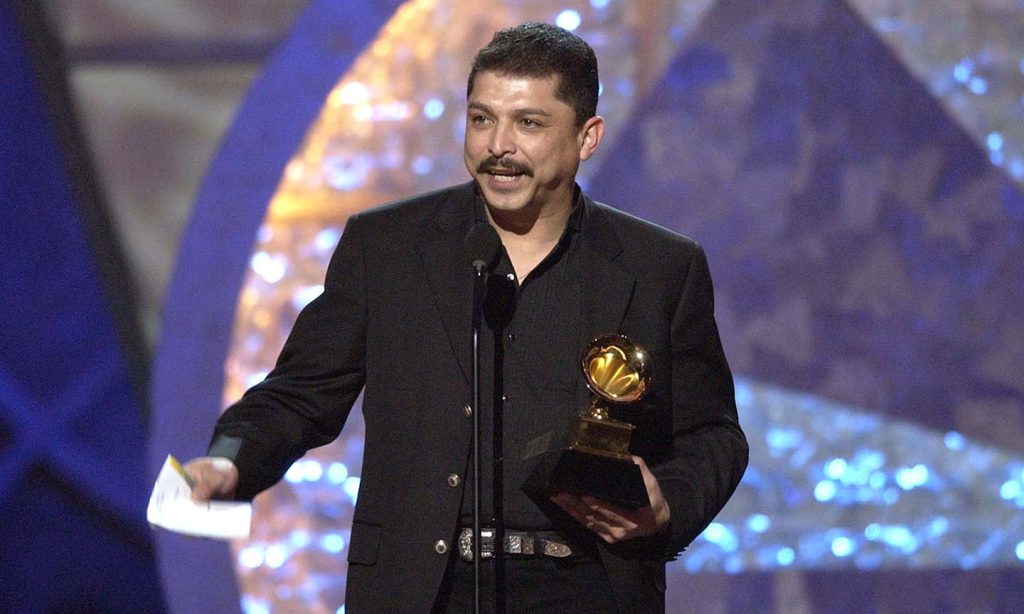Photo: M. Caulfield/WireImage
The name Emilio Navaira is synonymous with Tejano music. His music, life, and legacy are remembered by Tejano fans across the world, and it continues to grow even after his unexpected death from a heart attack in May 2016.
Selena Quintanilla-Perez is known by many as the Queen of Tejano, and an argument can be made for Emilio Navaira as the King. He brought Tejano music to the mainstream during the 1990s along with Selena. He even crossed over, garnering country music success, following the late great Freddy Fender.
Listen to the Latino Infused Country playlist now.
“[Emilio] was one of the greatest entertainers, period,” said his son Diego Navaira. “If you ever got to see an Emilio Navaira Y Grupo Rio concert, especially in the 90s, consider yourself lucky. Those shows were mighty. He gave it his all, every time. With all due respect, no other male Tejano artist has done national television, toured the world, has a fan base throughout Mexico like he has, or is in the Smithsonian. Also, con todo respecto (with all respect), the Astrodome concert that everyone talks about Selena selling out was a co-headlined show with Emilio. Not many remember that.”
Emilio Navaira grew up on the south side of San Antonio, Texas, singing at an early age and even getting his first solo in his school choir. Emilio’s brother, Raul “Raulito” Navaira, was by his side for many years, singing backup on stage with Grupo Rio. “I remember seeing my brother singing his first solo in middle school choir, and the girls went crazy for him, and I think that’s where he got his taste for [it],” said Raulito. “Emilio was born an entertainer!”
Emilio Navaira – No Es El Fin Del Mundo
Click to load video
Emilio continued singing through high school, performing in competitions, and eventually earning a music scholarship to Southwest Texas State University, now Texas State University, to pursue a career as a music teacher. Performing, however, was his true calling. In 1983, Emilio joined Tejano group David Lee Garza Y Los Musicales as lead singer at the age of 21, eventually launching a solo career with his own band Grupo Rio just a few years later in 1989. His self-titled debut album was nominated for a Grammy Award for Best Mexican-American Album in 1990, as well as his album Unsung Highways in 1993.
“When we were kids, I thought it was completely normal having a dad who was a famous singer,” said his son Emilio Navaira IV. “It wasn’t until me and Diego became teenagers that we realized how famous he was, and the career he had made for himself and our family. He was different. He took risks. He was bold. He brought his culture to the masses, which I don’t think can be said for other male Tejano artists. He infused rock, country, and pop with conjunto and ranchera music.”
Emilio Navaira – Como Le Hare
Click to load video
The success of Emilio Navaira in Tejano music earned him the nickname “The Garth Brooks of Tejano.” Companies like Coca-Cola and Wrangler used his music for national commercials. After a sponsorship with Miller Lite, Emilio borrowed the company’s slogan for the title of his debut country album Life Is Good. He even created a trademark dance, “The Emilio Shuffle,” that he performed on stage with brother Raulito.
Emilio’s country crossover began in the mid-’90s when he signed with Capitol Records Nashville. “It’s Not the End of the World” was the lead single from his debut country album, reaching the Top 30 of the Country charts in 1995. The album was a success, reaching No. 13 on the Country albums chart.
It’s Not The End Of The World
Click to load video
The follow-up, It’s On The House, released in 1997 was not quite as successful as his debut disc, peaking at No. 50 on the country albums chart. He returned to Tejano music earning a Best Tejano Album Grammy Award in 2003 for Acuerdate and a Latin Grammy in 2007 for Best Tejano Album with De Nuevo.
“Emilio broke attendance records as a Tejano artist at livestock and rodeo shows,” explains Ramón Hernández, journalist and founder of Hispanic Entertainment Archives, who curated an exhibit honoring Emilio at Texas State University in 2016. “He filled arenas in Mexico, won coveted Grammy Awards, and dominated the Tejano Music Awards for years. He continued his upward climb when he recorded country music and went on tour with George Strait, Alan Jackson and other top C&W artists.”
Committed to giving back to the community that raised him, Emilio began a charity in 1998 called Emilio Navaira Tejanos for Children. The non-profit has raised hundreds of thousands of dollars for the Santa Rosa Children’s Hospital in San Antonio and the Children’s Miracle Network. “He was a generous man. He was a giver,” added Emilio IV. “He was the kind of person who looked after everyone else before even thinking of himself.”
Emilio Navaira – Ya No Me Pones Atención
Click to load video
In March 2008, Emilio was critically injured and hospitalized when the tour bus he was driving crashed on the highway after a nightclub performance in Houston. A blood clot was removed from his head, and he was kept in a medically induced coma and hypothermia to prevent brain swelling. After multiple surgeries and years of recovery, Emilio was able to return to the stage and released another album, A Las Personas de mi Vida, in 2012. His sons, Emilio IV and Diego, were able to perform with him as part of Grupo Rio during the comeback. Sadly, Emilio’s return to music ended just a few short years later when he died of a sudden heart attack at the age of 53 in May 2016.
Upon his passing, Neil Portnow, President/CEO of The Recording Academy, put it thusly: “Possessing one of the greatest voices in the history of Tejano music, Emilio Navaira was an icon in the genre… He showcased his strong Texas roots in everything he did… Emilio was beloved by many, and helped to shape an entire genre of music.”
The Navaira musical legacy continues with his sons, Emilio IV and Diego, as members of Tex-Mex Rock band The Last Bandoleros, who infused their roots and culture on their latest album Tex Flex. “We just want to create and perform music that we love, because that’s what he did, and that’s what he’d want us to do,” said Emilio IV.
Destiny Navaira, daughter of Raulito and niece of Emilio, has also been successful in the Tejano music industry, winning Female Vocalist of the Year at the Tejano Music Awards in 2021 and sweeping the Best New Artist categories in 2016 with her brother Rigo Navaira and their band Remedio. “He was more than just musically successful. He was somewhat of an icon, somewhat of a figure, an idol to a lot of people,” Destiny said. “I think that’s why he’s known as the King. He created a different sound, there is nothing that you can compare it to.”
There is little you can compare it to from back then, but that’s not the case today. Navaira’s music continues to be influential among a new generation. In short, he’s a Tejano legend, one whose name will not soon be forgotten.



